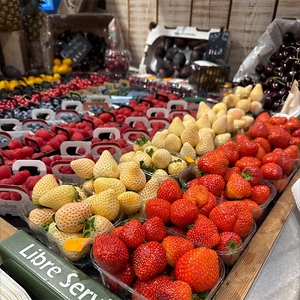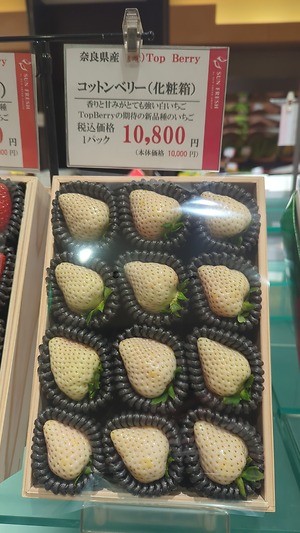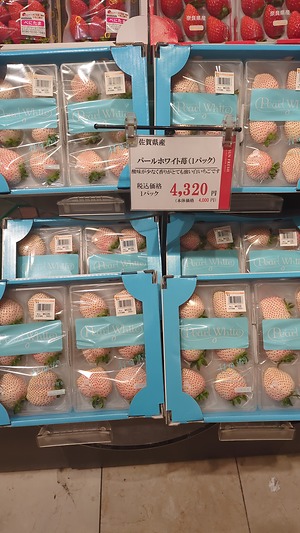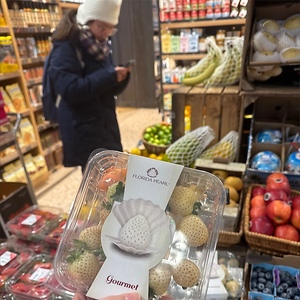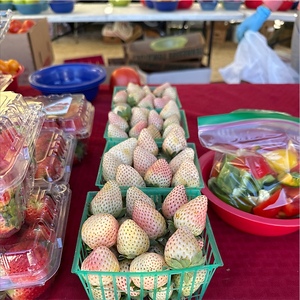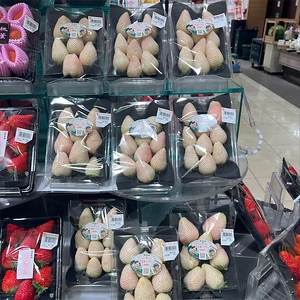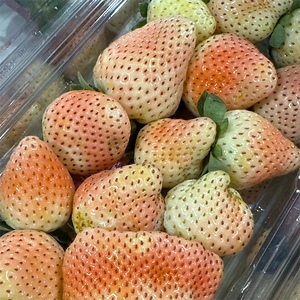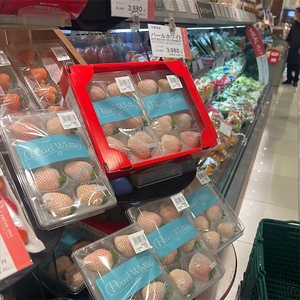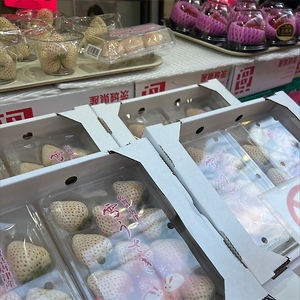

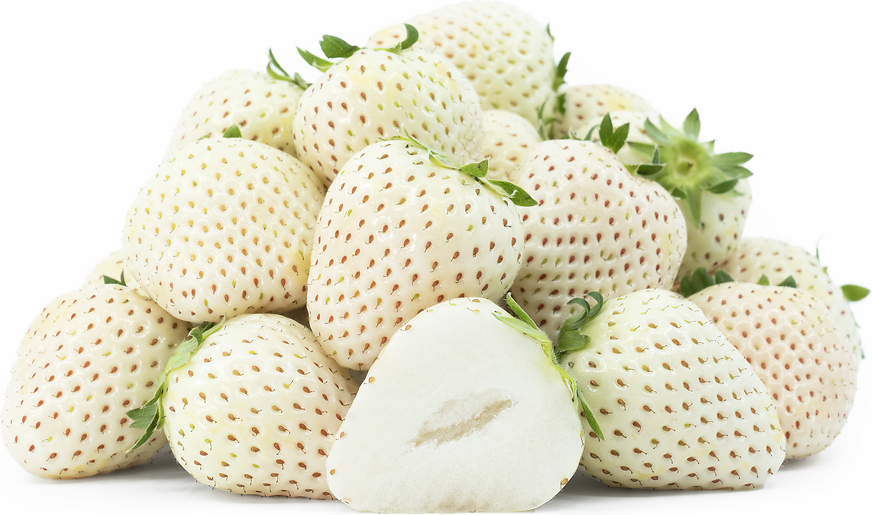
White Strawberries
Estimated Inventory, 200 gm : 0
This item was last sold on : 05/12/25
Description/Taste
White strawberries widely range in size and shape, depending on the variety, and generally have a conical appearance comprised of curved, broad shoulders tapering to a blunt or pointed tip. The skin is thin, smooth, glossy, and taut, with a delicate, easily bruised nature, and the fruits are capped with lanceolate-shaped green leaves that grow in a circular formation. White strawberries are found in shades of white to ivory, dotted with bright red seeds, and covered in the occasional pink blush. Underneath the surface, the white flesh is soft, aromatic, dense, and aqueous with a crisp but tender consistency. The fruit's core can also be solid or hollow, depending on cultivation, growing environment, and specific varietal. White strawberries are aromatic and release a subtly sweet, fruity scent. When ripe, White strawberries can have a complex flavoring ranging from tropical and tangy, pineapple-like flavors to a mild, candy-like sweetness with a lingering brightness on the palate.
Seasons/Availability
White strawberries are available year-round, with a peak season in the winter through early spring.
Current Facts
White strawberries, botanically a part of the Fragaria genus, are a category of rare, specialty fruits belonging to the Rosaceae family. There are many varieties of White strawberries commercially produced worldwide, and each cultivar varies in appearance, flavor, and texture. White strawberries are not a new type of strawberry. Historically, varieties such as Alpine, Beach, and Pineberries have naturally occurred as mutations of red strawberries in the wild for centuries. Despite their longstanding presence, many of these white-hued varieties remained localized to specific regions and did not gain commercial attention. White strawberries became known worldwide when Japanese growers developed newer commercial cultivars for broader consumer appeal. White strawberries are not genetically modified and have been naturally bred over many years to create pale fruits with a sweet, subtly tangy flavor. In Japan, the first commercial White strawberry, Hatsukoi no Kaori, meaning “scent of first love,” was released in the early 21st century and quickly became a favorite variety grown for the Japanese luxury fruit market. Over 50 cultivars of White strawberries have been created for modern markets, and since their commercial release, the fruits have been sold as a delicacy. Popular varieties of White strawberries include Pearl White, White Rabbit, and White Jewel. White strawberries are premium fresh-eating fruits valued for their unusual coloring, delicate flavor, and soft texture.
Nutritional Value
White strawberries are a source of vitamin C to strengthen the immune system while reducing inflammation, vitamin A to maintain healthy organ functioning, and potassium to balance fluid levels within the body. The fruits also provide some fiber to regulate the digestive tract, calcium to build strong bones and teeth, vitamin K to assist in faster wound healing, and other nutrients, including iron, vitamin E, magnesium, zinc, phosphorus, zinc, and manganese.
Applications
White strawberries have a soft, aqueous consistency and a sweet, fruity, and tangy flavor suited for fresh preparations. The fruits are traditionally consumed straight out of hand and are savored for their distinct flavoring and succulent texture. White strawberries can be served as a stand-alone snack, sometimes dipped in condensed milk or chocolate, or they can be sliced into salads, used as a topping over desserts, sliced and layered over toast, or served with red strawberries on cheese platters for a colorful appearance. In Japan, White strawberries are placed onto cakes, tarts, custards, and parfaits, or they are sliced in half and served over pancakes, ice cream, and cheesecakes. The fruits are also given as gifts during special occasions, often enclosed in ornate packaging, and are mainly eaten fresh out of respect to the fruit’s rarity. Beyond culinary applications, White strawberries can be used as an edible garnish on a cocktail glass rim to elevate a beverage. White strawberries pair well with vanilla, cinnamon, caramel, soft cheeses such as goat, burrata, and ricotta, and fruits such as apples, peaches, grapes, and apricots. Whole, unwashed White strawberries will keep for 2 to 3 days when stored in the refrigerator. It is recommended to immediately consume the fruits for the best quality and flavor.
Ethnic/Cultural Info
Shiroi Houseki, also known as the White Jewel strawberry, is often deemed the most expensive White strawberry commercially available in Japan. Breeder and farmer Yasuhito Teshima spent years developing and perfecting the variety through natural crossbreeding techniques, and White Jewel strawberries were first released commercially in 2012. Teshima claims White Jewel strawberries are also the largest and whitest of the White strawberry varieties found in Japan. During cultivation, the fruits are limited in their exposure to sunlight, preventing the flesh from developing anthocyanin, the pigment responsible for the strawberry’s bright red hue. With this lack of light exposure and through expert breeding techniques, White Jewel strawberries have a white, soft, juicy, and tender flesh with a distinct, candy-like tropical flavor. Despite their fame as a luxury fruit, White Jewel strawberries are also considered rare as they are grown in limited quantities by Teshima in the Saga Prefecture. Each year, only around ten percent of the White Jewel strawberries develop a pure white hue, even after Teshima’s years of extensive trials and testing, contributing to the cultivar’s exclusivity. White Jewel strawberries are highly desired for their rarity, and once selected and packaged for markets, White strawberries are often sold at very high prices, depending on the shape, size, number of berries, and appearance.
Geography/History
White strawberry is a general category encompassing hybrid varieties developed either naturally in the wild or through years of traditional and natural crossbreeding techniques. In Japan, it took researchers over 20 years to establish a maintained quality for commercial White strawberry production. Hatsukoi no Kaori was one of the first White strawberries produced in Japan, developed by Miyokshi Agritech, and was released in 2009 through high-end department stores. Over time, many new breeders began to create varieties of White strawberries across Japan, including the famous White Jewel in 2012. Today White strawberries are grown in Saga, Nara, Yamanashi, Chiba, and Tochigi prefectures in Japan and are produced through a limited number of growers to maintain the fruit’s rare reputation. The fruits are primarily sold through supermarkets, department stores, luxury fruit markets, and online retailers, and some varieties are also exported to other countries.
Recipe Ideas
Recipes that include White Strawberries. One
| Edible Tampa Bay |
|
Pineberry Cloud Tart |
Podcast



